"The HIRING Desk"
Proposed by
(Job Portal)


to Address the Issues of
- A Digital Solution
Skill Shortages and Skill Mismatches
Using Systems Thinking Approach
in a Region
"The HIRING Desk"
- A Digital Solution
Proposed by Using Systems Thinking Approach
to Address the Issues of
Skill Shortages & Skill Mismatches in a Region
(Job Portal)


Problem Statement
In today’s rapidly evolving job market, skill shortages present a significant challenge for both employers and job seekers. The mismatch between the skills possessed by candidates and those demanded by employers creates barriers to employment, hinders workforce productivity, and slows economic growth. To address this critical issue, innovative solutions are needed—solutions that go beyond merely alleviating the symptoms of skill shortages and focus on tackling their root causes.
Background
In my PhD thesis titled “Critical Analysis of Skill Shortages & Its Effect on the Financial Services Sector: A Comparative Study of Selected Commercial Banks & Insurance Companies in Aurangabad City,” I examined these skill shortages and mismatches in detail. The study highlighted the urgent need for a solution that could bridge the gap between the skills possessed by the workforce and the skills required by employers.
To address this challenge, I proposed a digital solution called The Hiring Desk, designed to reduce skill shortages and better align the workforce's skills with the demands of the job market. This problem was examined using a Systems Thinking approach, which provided a holistic view of the issue. I developed a detailed Causal Loop Diagram and referred to Donella Meadows' Leverage Points to identify key leverage points and propose effective intervention strategies.
Problem Statement
In today’s rapidly evolving job market, skill shortages present a significant challenge for both employers and job seekers. The mismatch between the skills possessed by candidates and those demanded by employers creates barriers to employment, hinders workforce productivity, and slows economic growth. To address this critical issue, innovative solutions are needed—solutions that go beyond merely alleviating the symptoms of skill shortages and focus on tackling their root causes.
Background
In my PhD thesis titled “Critical Analysis of Skill Shortages & Its Effect on the Financial Services Sector: A Comparative Study of Selected Commercial Banks & Insurance Companies in Aurangabad City,” I examined these skill shortages and mismatches in detail. The study highlighted the urgent need for a solution that could bridge the gap between the skills possessed by the workforce and the skills required by employers.
To address this challenge, I proposed a digital solution called Hiring Desk, designed to reduce skill shortages and better align the workforce's skills with the demands of the job market. This problem was examined using a Systems Thinking approach, which provided a holistic view of the issue. I developed a detailed Causal Loop Diagram and referred to Donella Meadows' Leverage Points to identify key leverage points and propose effective intervention strategies.
Understanding the Systems Thinking Approach and Leverage Points
This study adopts a Systems Thinking approach to identify leverage points in the region's skill shortages and skill mismatches. A key component of this methodology is the creation of a Causal Loop Diagram (CLD), which visually represents the interconnected feedback loops that contribute to these issues.
For readers unfamiliar with these concepts, I have included a Systems Thinking Glossary to clarify key terms and help ensure a thorough understanding of the terminology used throughout this case study. The glossary provides clear definitions of essential Systems Thinking principles, including how to interpret a Causal Loop Diagram.
Additionally, I have provided Donella Meadows' diagram of leverage points, which outlines twelve potential intervention areas within any system. This diagram will help readers understand which leverage points I have selected for this study, why these particular points were chosen, and how they influence the design and strategy behind the proposed digital platform to effectively address skill shortages.
Understanding the Systems Thinking Approach and Leverage Points
This study adopts a Systems Thinking approach to identify leverage points in the region's skill shortages and skill mismatches. A key component of this methodology is the creation of a Causal Loop Diagram (CLD), which visually represents the interconnected feedback loops that contribute to these issues.
For readers unfamiliar with these concepts, I have included a Systems Thinking Glossary to clarify key terms and help ensure a thorough understanding of the terminology used throughout this case study. The glossary provides clear definitions of essential Systems Thinking principles, including how to interpret a Causal Loop Diagram.
Additionally, I have provided Donella Meadows' diagram of leverage points, which outlines twelve potential intervention areas within any system. This diagram will help readers understand which leverage points I have selected for this study, why these particular points were chosen, and how they influence the design and strategy behind the proposed digital platform to effectively address skill shortages.
Selected Systems Thinking Terminology
Systems : A system is nothing but a group of elements or components that are interconnected and interdependent on one another and are functioning toward a common goal. According Donella H. Meadows [1] a system must necessarily contain three factors: “elements, interconnections, and a function or purpose”.
Systems Thinking : The term "Systems Thinking" is attributed to having been coined by Barry Richmond [2] in 1987, who is a renowned pioneer in the fields of systems thinking and systems dynamics. According to him, “Systems Thinking” is the art and science of making reliable inferences about behavior by developing an increasingly deep understanding of underlying structure.” Renowned systems thinker Peter Senge [3] describes Systems thinking as a discipline to understand totalities and a framework for recognize relationships over objects, to observe changing patterns instead of stationary pictures.
In a nutshell, Systems Thinking Problem solving approach means observing problem as a whole rather than part, understanding relationships over objects, and recognizing processes over structures.
Feedback Loop: Feedback Loop is a 'system' process in which output is used as input, prompting new cycles of future actions.
Reinforcing Loop or Positive Feedback Loop: A reinforcing loop occurs when one activity leads to an outcome that impacts other instances of the same action, either growth or fall. It reflects the pattern in which the end result reinforces the original action and amplifies the changes. It creates the vicious cycle of the events
Balancing Feedback Loop or Negative Feedback Loop: Balancing feedback loop is a process that prevents additional deviations in one direction by slowing down a process. It promotes change in opposite directions by resisting the change in one direction, which stabilizes a system. To accomplish a particular objective, Balancing loops are self-regulatory and cause corrective actions.
Causal Loop Diagram (CLD): A causal loop diagram is a visual diagram that helps to illustrate the causal relationships among various system variables. A causal loop diagram comprises of four basic components
The variables
The connections: i.e. links with arrows which indicate the relations between variables.
The signs: The signs on the links which demonstrate how one variable influences and has an impact on another variable. Which are Plus (+) or “s” & Minus (-) or “o” signs. When one variable changes, the second variable also changes in the same direction, then it is indicated by a Plus (+) or “s” sign. And the Minus (-) or “o” sign indicates that the first variable changes the second variable in the opposite direction. The Signs of the loop which display the kind of behaviors the system will exhibit. viz. Reinforcing Loops & Balancing Loops
Delays: The time gap between an action and a reaction along each system link is termed as Delay and it is denoted by hash mark “║” on links. Delays can cause system instability and hinder a system's ability to accomplish its objective. Delays generally conceal both planned and unintentional results of activities since the time taken is sometimes greater than anticipated. There are four types of delays – Physical Delays, Transactional Delays, Informational Delays, and Delays in Perception.
Donella H. Meadows, in her book "Thinking in Systems" [4] mentions twelve leverage points. She has mentioned these points in reverse order, moving from easy to difficult points. The more difficult to apply these interventions the greater they create impact on the system.
First 12 to 10 leverage points are related to physical events. Next 9 to 6 points are regarding information and patterns of behavior. Further 5to 3 points she states about the social & structural leverage points and top 1 & 2 are related to the consciousness and mental models.
Identification of the Leverage Points for the Interventions


Selected Systems Thinking Terminology
Systems : A system is nothing but a group of elements or components that are interconnected and interdependent on one another and are functioning toward a common goal. According Donella H. Meadows [1] a system must necessarily contain three factors: “elements, interconnections, and a function or purpose”.
Systems Thinking : The term "Systems Thinking" is attributed to having been coined by Barry Richmond [2] in 1987, who is a renowned pioneer in the fields of systems thinking and systems dynamics. According to him, “Systems Thinking” is the art and science of making reliable inferences about behavior by developing an increasingly deep understanding of underlying structure.” Renowned systems thinker Peter Senge [3] describes Systems thinking as a discipline to understand totalities and a framework for recognize relationships over objects, to observe changing patterns instead of stationary pictures.
In a nutshell, Systems Thinking Problem solving approach means observing problem as a whole rather than part, understanding relationships over objects, and recognizing processes over structures.
Feedback Loop: Feedback Loop is a 'system' process in which output is used as input, prompting new cycles of future actions.
Reinforcing Loop or Positive Feedback Loop: A reinforcing loop occurs when one activity leads to an outcome that impacts other instances of the same action, either growth or fall. It reflects the pattern in which the end result reinforces the original action and amplifies the changes. It creates the vicious cycle of the events
Balancing Feedback Loop or Negative Feedback Loop: Balancing feedback loop is a process that prevents additional deviations in one direction by slowing down a process. It promotes change in opposite directions by resisting the change in one direction, which stabilizes a system. To accomplish a particular objective, Balancing loops are self-regulatory and cause corrective actions.
Causal Loop Diagram (CLD): A causal loop diagram is a visual diagram that helps to illustrate the causal relationships among various system variables. A causal loop diagram comprises of four basic components
The variables
The connections: i.e. links with arrows which indicate the relations between variables.
The signs: The signs on the links which demonstrate how one variable influences and has an impact on another variable. Which are Plus (+) or “s” & Minus (-) or “o” signs. When one variable changes, the second variable also changes in the same direction, then it is indicated by a Plus (+) or “s” sign. And the Minus (-) or “o” sign indicates that the first variable changes the second variable in the opposite direction. The Signs of the loop which display the kind of behaviors the system will exhibit. viz. Reinforcing Loops & Balancing Loops
Delays: The time gap between an action and a reaction along each system link is termed as Delay and it is denoted by hash mark “║” on links. Delays can cause system instability and hinder a system's ability to accomplish its objective. Delays generally conceal both planned and unintentional results of activities since the time taken is sometimes greater than anticipated. There are four types of delays – Physical Delays, Transactional Delays, Informational Delays, and Delays in Perception.
Donella H. Meadows, in her book "Thinking in Systems" [4] mentions twelve leverage points. She has mentioned these points in reverse order, moving from easy to difficult points. The more difficult to apply these interventions the greater they create impact on the system.
First 12 to 10 leverage points are related to physical events. Next 9 to 6 points are regarding information and patterns of behavior. Further 5to 3 points she states about the social & structural leverage points and top 1 & 2 are related to the consciousness and mental models.
Identification of the Leverage Points for the Interventions


Observations from the Figure 5.1 - Causal Loop Diagram (CLD) of Skill Shortages and Mismatch - Identification of Leverage Points
Without the proper involvement of Job Seekers and Educational Institutes, the reinforcing loop of Skills Shortages/ Mismatch and unfilled vacancies can be observed in the diagram which may result into a vicious cycle.
However, timely preparations by the job seekers create a balancing loop which results in reduction of skills shortages and mismatch.
Preparing for the job is the key process in the filling the vacancies and increasing the employment rate. This process involves Job Seekers as well as Educational Institutes. The ideal situation may create a reinforcing loop of higher employment rates.
But delays may reflect some consequences in this overall reinforcing loop.
Causal Loop Diagram (CLD) of Skill Shortages and Mismatch - Identification of Leverage Points


Current Scenario and Identification of Leverage Points:
During the research, by analyzing primary & secondary data and the Figure 5.1 - Causal Loop Diagram (CLD) of Skill Shortages and Mismatch, it has been observed that -
The employers have unanimously echoed that the Job Seekers and Educational Institutes play Very Important Role in mitigating the Skills Shortages from the region.(ref. Table No. 4.5c.1 of the my PhD thesis)
The Figure 5.1 - Causal Loop Diagram (CLD) of Skill Shortages and Mismatch as well reflects that the Job Seekers and the Educational Institutes have greater influence on reducing the Skills Shortages.
Further, Figure 5.1 - Causal Loop Diagram (CLD) of Skill Shortages and Mismatch shows that employers' delay or failure to communicate new skills in-demand to job seekers and educational institutions may result in a delayed process of job preparation.
Employers have vacancies but they are unable to fill them because of certain reasons. They don’t have any medium to express their views regarding hiring issues to the appropriate stakeholders.
On the other hand, job Seekers, especially fresher; do not have any channels to learn about the highly demanded skills & changing trends of the job market.
The Educational Institutes to understand about the changing scenarios of the hiring trends and employments in the region, rely upon academic research, conferences or other reports.
Delays in the flow of information from employers to job seekers and educational institutes may further stall the process of preparing job seekers for employment.
Hence it is observed that there is ‘a huge gap mainly related to the communication among the different stakeholders’ about the issues faced by them related to employments, which, to the large extent, contributes to the vicious cycle of Skill Shortages or Skill Mismatch in the region.
Donella H. Meadows, in her book has placed the Delays at the 9th place in the list of leverage points. She mentions Delay length as a high leverage point [5]. She states that delays are often difficult to change. However, if there is a delay in the system that may be altered, then doing so could result in significant impacts.
Observations from the Figure 5.1 - Causal Loop Diagram (CLD) of Skill Shortages and Mismatch - Identification of Leverage Points
Without the proper involvement of Job Seekers and Educational Institutes, the reinforcing loop of Skills Shortages/ Mismatch and unfilled vacancies can be observed in the diagram which may result into a vicious cycle.
However, timely preparations by the job seekers create a balancing loop which results in reduction of skills shortages and mismatch.
Preparing for the job is the key process in the filling the vacancies and increasing the employment rate. This process involves Job Seekers as well as Educational Institutes. The ideal situation may create a reinforcing loop of higher employment rates.
But delays may reflect some consequences in this overall reinforcing loop.
Causal Loop Diagram (CLD) of Skill Shortages and Mismatch - Identification of Leverage Points


Current Scenario and Identification of Leverage Points:
During the research, by analyzing primary & secondary data and the Figure 5.1 - Causal Loop Diagram (CLD) of Skill Shortages and Mismatch, it has been observed that -
The employers have unanimously echoed that the Job Seekers and Educational Institutes play Very Important Role in mitigating the Skills Shortages from the region.(ref. Table No. 4.5c.1 of the my PhD thesis)
The Figure 5.1 - Causal Loop Diagram (CLD) of Skill Shortages and Mismatch as well reflects that the Job Seekers and the Educational Institutes have greater influence on reducing the Skills Shortages.
Further, Figure 5.1 - Causal Loop Diagram (CLD) of Skill Shortages and Mismatch shows that employers' delay or failure to communicate new skills in-demand to job seekers and educational institutions may result in a delayed process of job preparation.
Employers have vacancies but they are unable to fill them because of certain reasons. They don’t have any medium to express their views regarding hiring issues to the appropriate stakeholders.
On the other hand, job Seekers, especially fresher; do not have any channels to learn about the highly demanded skills & changing trends of the job market.
The Educational Institutes to understand about the changing scenarios of the hiring trends and employments in the region, rely upon academic research, conferences or other reports.
Delays in the flow of information from employers to job seekers and educational institutes may further stall the process of preparing job seekers for employment.
Hence it is observed that there is ‘a huge gap mainly related to the communication among the different stakeholders’ about the issues faced by them related to employments, which, to the large extent, contributes to the vicious cycle of Skill Shortages or Skill Mismatch in the region.
Donella H. Meadows, in her book has placed the Delays at the 9th place in the list of leverage points. She mentions Delay length as a high leverage point [5]. She states that delays are often difficult to change. However, if there is a delay in the system that may be altered, then doing so could result in significant impacts.
Introducing "The HIRING Desk": A Transformative Solution
To bring all the relevant stakeholders of a region, viz., Job Seeker, Educational Institutes and Employers, together on one platform
To cut down on information delays
To build a robust communication, feedback and review system.
The Goals of "The HIRING Desk"
In light of the 9th leverage point, the "delay" suggested by Donella H. Meadows [6] and in context of the primary and secondary data of the study as well as the Figure 5.1 - Causal Loop Diagram (CLD) of Skill Shortages and Mismatch, the leverage point should involve both Job Seekers and Educational Institutes and their timely communication and information flow with Employers.
Hence , “The HIRING Desk”, a job portal, is proposed as a digital solution to provide a single platform to all stakeholders and to establish a strong & timely communication system among them.
"The HIRING Desk" (Job Portal) - The Proposed Digital Solution
To bring all the relevant stakeholders of a region, viz., Job Seeker, Educational Institutes and Employers, together on one platform
To cut down on information delays
To build a robust communication, feedback and review system.
The Goals of "the Hiring Desk"
In light of the 9th leverage point, the "delay" suggested by Donella H. Meadows [6] and in context of the primary and secondary data of the study as well as the Figure 5.1 - Causal Loop Diagram (CLD) of Skill Shortages and Mismatch, the leverage point should involve both Job Seekers and Educational Institutes and their timely communication and information flow with Employers.
Hence “The HIRING Desk”, a job portal, is proposed as a digital solution to provide a single platform to all stakeholders and to establish a strong & timely communication system among them.
Features of “The HIRING Desk”
“The HIRING Desk” is a job portal designed with an aim of addressing the issues of Skills Shortages and Mismatch in a particular region.
The Educational Institute would be the administrator of the site.
Employers and Job seekers would register on the site.
The employers would post job openings on this portal.
Job seekers would be able to make resumes and apply for the jobs posted on the site.
The Educational Institute would be communicating with Employers and Job Seekers through the portal as and when required.
The Educational Institute would keep observing the activities of the Employers and the Job Seekers through its dashboard.
As a result of this site, all the stakeholders would be able to communicate and give feedback to each other to improve the region’s position with regard to skill shortages, skill mismatches, and unemployment.
The data and information acquired through this website would broaden the understanding of the situation and serve as a foundation for taking additional measures.
User Personas
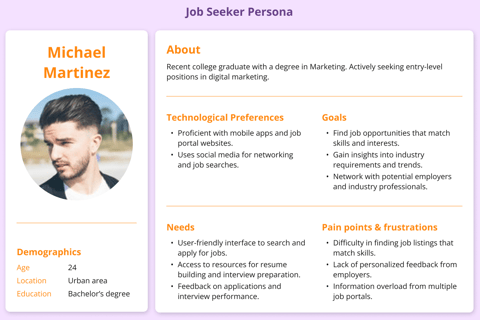

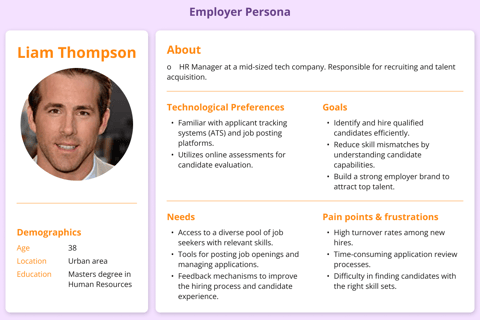

In developing "The HIRING Desk," user personas are crucial for addressing stakeholders' diverse needs. By creating four personas—Job Seeker, Employer, Educational Institute Representative, and Training Provider—we gain insights into each group's unique goals and challenges.


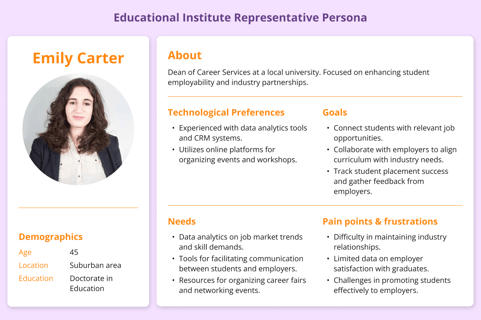

User Personas






In developing "The HIRING Desk," user personas are crucial for addressing stakeholders' diverse needs. By creating four personas—Job Seeker, Employer, Educational Institute Representative, and Training Provider—we gain insights into each group's unique goals and challenges.


Features of “The HIRING Desk”
The features of “The HIRING Desk” are designed to provide a comprehensive solution to the challenges of skills shortages and mismatches in the job market. Here’s how each feature contributes to the overall effectiveness of the platform:
1. Targeted Job Portal:
Description: “The HIRING Desk” serves as a specialized job portal aimed at solving the issues of skills shortages and mismatches in a specific region.
Impact: Facilitates targeted connections between job seekers and employers based on local needs.
2. Administrator Role of Educational Institute:
Description: The Educational Institute acts as the site administrator, overseeing its operations and user interactions.
Impact: Ensures reliable management of content and user activities, fostering a trustworthy environment.
3. User Registration for Employers and Job Seekers:
Description: Both Employers and Job Seekers can register on the platform to create personalized profiles.
Impact: Enhances user engagement and allows tailored experiences for both groups.
4. Job Posting Functionality:
Description: Employers can post job openings on the portal, detailing qualifications and application requirements.
Impact: Reduces recruitment time and helps attract suitable candidates for job vacancies.
5. Resume Creation and Job Application Process:
Description: Job Seekers can create resumes and apply for jobs directly through the site.
Impact: Streamlines the application process, making it more accessible for job seekers.
Description: The platform facilitates communication between the Educational Institute, Employers, and Job Seekers.
Impact: Promotes timely interactions and updates, improving collaboration among stakeholders.
6. Integrated Communication Tools:
7. Activity Monitoring Dashboard:
Description: The Educational Institute can monitor user activities through an intuitive dashboard.
Impact: Provides insights into engagement and trends, helping to identify areas for improvement.
Description: All stakeholders can communicate and provide feedback through the platform.
Impact: Encourages continuous improvement of the platform and addresses the needs of the region regarding skills and employment.
8. Feedback Mechanism:
9. Data and Information Collection:
Description: The platform collects data and information from user interactions and activities.
Impact: Broadens the understanding of local skill shortages and mismatches, serving as a foundation for strategic decision-making.
10. Foundation for Future Measures:
Description: The insights gained from the platform can inform additional initiatives and policies.
Impact: Empowers stakeholders to take proactive steps to enhance regional employment and skill alignment.
Features of “The HIRING Desk”
The features of “The HIRING Desk” are designed to provide a comprehensive solution to the challenges of skills shortages and mismatches in the job market. Here’s how each feature contributes to the overall effectiveness of the platform:
1. Targeted Job Portal:
Description: “The HIRING Desk” serves as a specialized job portal aimed at solving the issues of skills shortages and mismatches in a specific region.
Impact: Facilitates targeted connections between job seekers and employers based on local needs.
2. Administrator Role of Educational Institute:
Description: The Educational Institute acts as the site administrator, overseeing its operations and user interactions.
Impact: Ensures reliable management of content and user activities, fostering a trustworthy environment.
3. User Registration for Employers and Job Seekers:
Description: Both Employers and Job Seekers can register on the platform to create personalized profiles.
Impact: Enhances user engagement and allows tailored experiences for both groups.
4. Job Posting Functionality:
Description: Employers can post job openings on the portal, detailing qualifications and application requirements.
Impact: Reduces recruitment time and helps attract suitable candidates for job vacancies.
5. Resume Creation and Job Application Process:
Description: Job Seekers can create resumes and apply for jobs directly through the site.
Impact: Streamlines the application process, making it more accessible for job seekers.
Description: The platform facilitates communication between the Educational Institute, Employers, and Job Seekers.
Impact: Promotes timely interactions and updates, improving collaboration among stakeholders.
6. Integrated Communication Tools:
7. Activity Monitoring Dashboard:
Description: The Educational Institute can monitor user activities through an intuitive dashboard.
Impact: Provides insights into engagement and trends, helping to identify areas for improvement.
Description: All stakeholders can communicate and provide feedback through the platform.
Impact: Encourages continuous improvement of the platform and addresses the needs of the region regarding skills and employment.
8. Feedback Mechanism:
9. Data and Information Collection:
Description: The platform collects data and information from user interactions and activities.
Impact: Broadens the understanding of local skill shortages and mismatches, serving as a foundation for strategic decision-making.
10. Foundation for Future Measures:
Description: The insights gained from the platform can inform additional initiatives and policies.
Impact: Empowers stakeholders to take proactive steps to enhance regional employment and skill alignment.
Features of “The HIRING Desk”
“The HIRING Desk” is a job portal designed with an aim of addressing the issues of Skills Shortages and Mismatch in a particular region.
The Educational Institute would be the administrator of the site.
Employers and Job seekers would register on the site.
The employers would post job openings on this portal.
Job seekers would be able to make resumes and apply for the jobs posted on the site.
The Educational Institute would be communicating with Employers and Job Seekers through the portal as and when required.
The Educational Institute would keep observing the activities of the Employers and the Job Seekers through its dashboard.
As a result of this site, all the stakeholders would be able to communicate and give feedback to each other to improve the region’s position with regard to skill shortages, skill mismatches, and unemployment.
The data and information acquired through this website would broaden the understanding of the situation and serve as a foundation for taking additional measures.
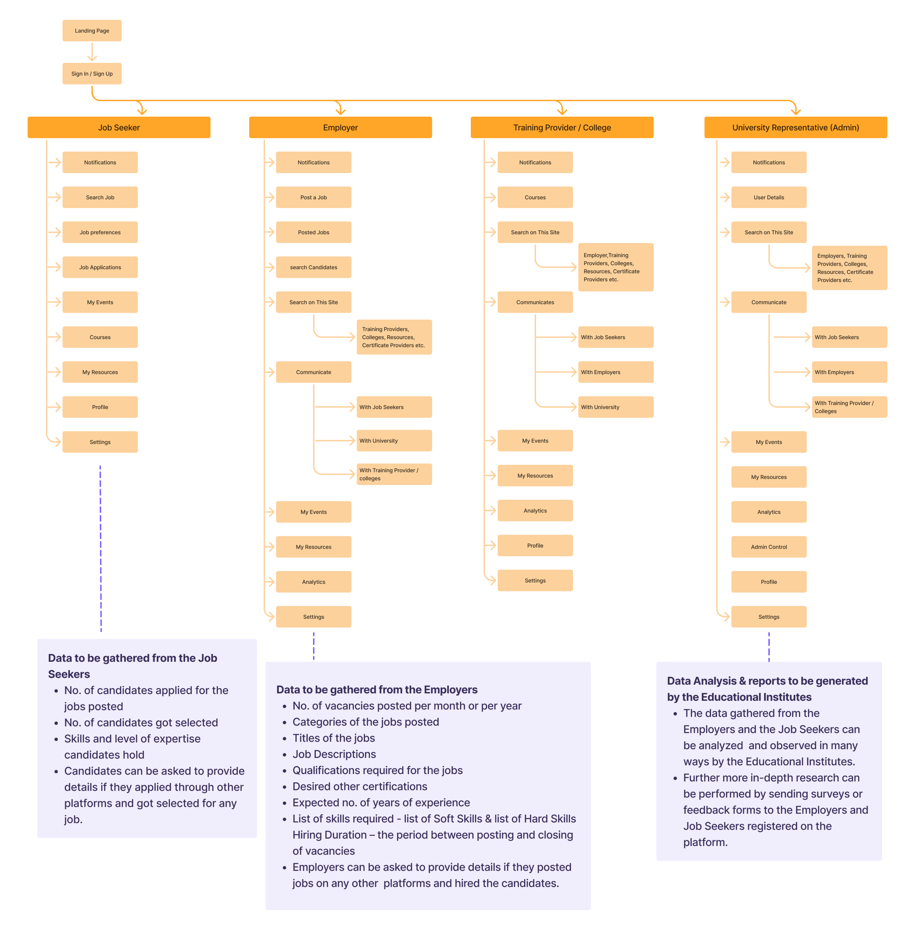

Sitemap & Expected Data Collection
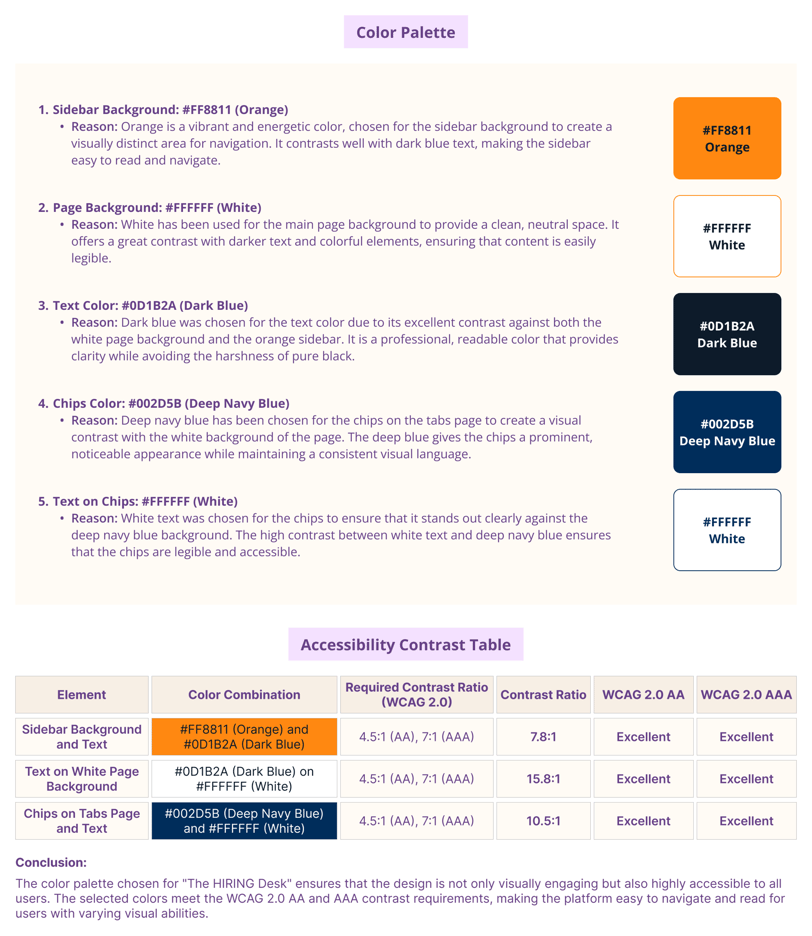

Screens & UI Design
I've designed four UI screens for my proposed job portal, 'The HIRING Desk,' each tailored to meet the specific needs of the key stakeholder personas. These designs aim to provide a personalized experience for each user, ensuring they can easily access the features most relevant to them. Each screen highlights the key functionalities that support the respective stakeholders, demonstrating how the platform will help them achieve their goals.
These designs not only showcase the intended user interface but also outline the logical flow of interactions within the system. By mapping out the user journeys, I’ve illustrated how Job Seekers, Employers, Educational Institutes, and Training Providers will navigate the platform to fulfill their needs effectively.
Additionally, these designs lay the groundwork for gathering user feedback, which will be crucial for refining the platform. This feedback loop will help ensure that the final design remains user-friendly and aligned with the expectations of the target audience, ultimately enhancing 'The HIRING Desk’s' ability to address skill shortages and mismatches.


Sitemap &
Expected Data Collection


Screens & UI Design
I've designed four UI screens for my proposed job portal, 'The HIRING Desk,' each tailored to meet the specific needs of the key stakeholder personas. These designs aim to provide a personalized experience for each user, ensuring they can easily access the features most relevant to them. Each screen highlights the key functionalities that support the respective stakeholders, demonstrating how the platform will help them achieve their goals.
These designs not only showcase the intended user interface but also outline the logical flow of interactions within the system. By mapping out the user journeys, I’ve illustrated how Job Seekers, Employers, Educational Institutes, and Training Providers will navigate the platform to fulfill their needs effectively.
Additionally, these designs lay the groundwork for gathering user feedback, which will be crucial for refining the platform. This feedback loop will help ensure that the final design remains user-friendly and aligned with the expectations of the target audience, ultimately enhancing 'The HIRING Desk’s' ability to address skill shortages and mismatches.
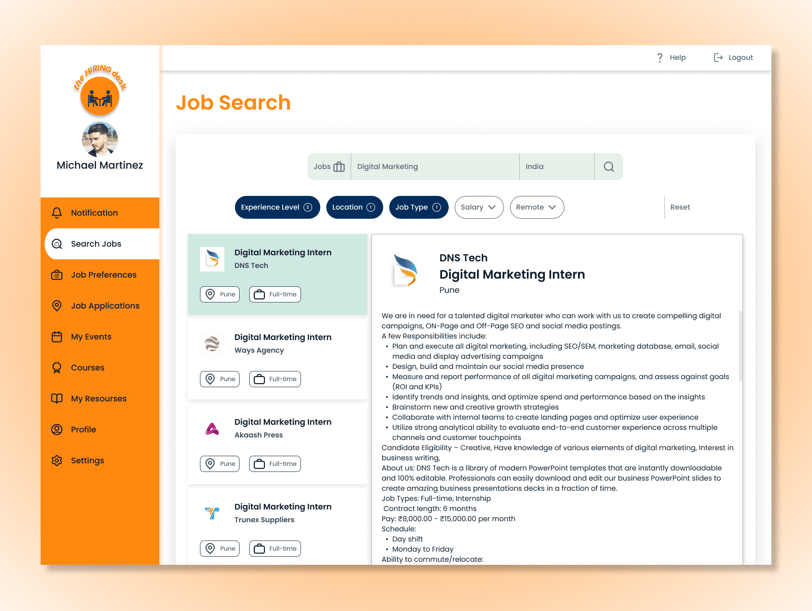

Job Seeker's Screen
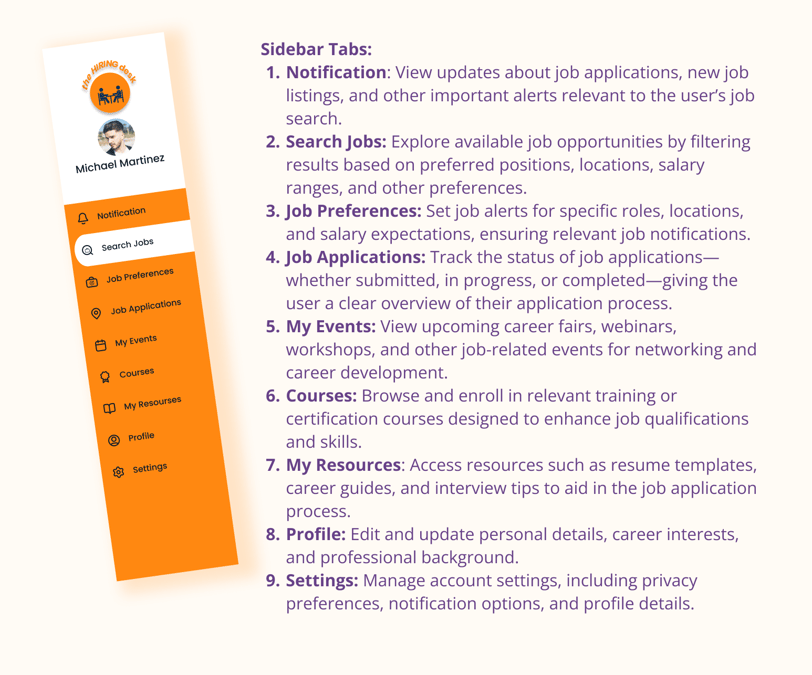



Job Seeker's Screen


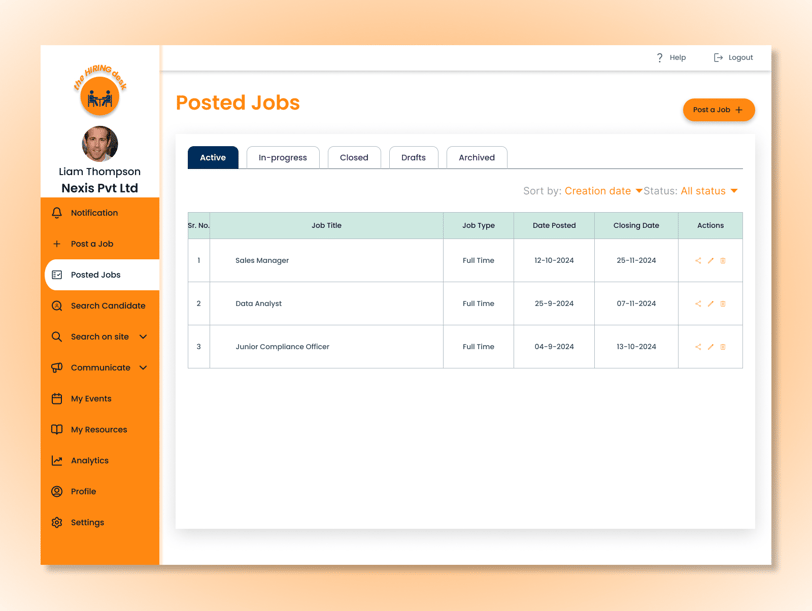

Employer's Screen
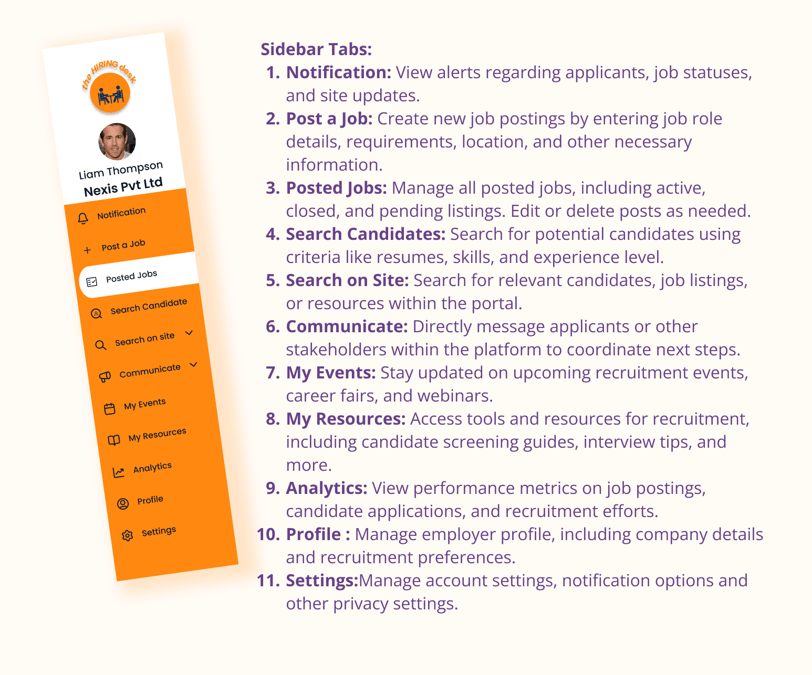



Employer's Screen


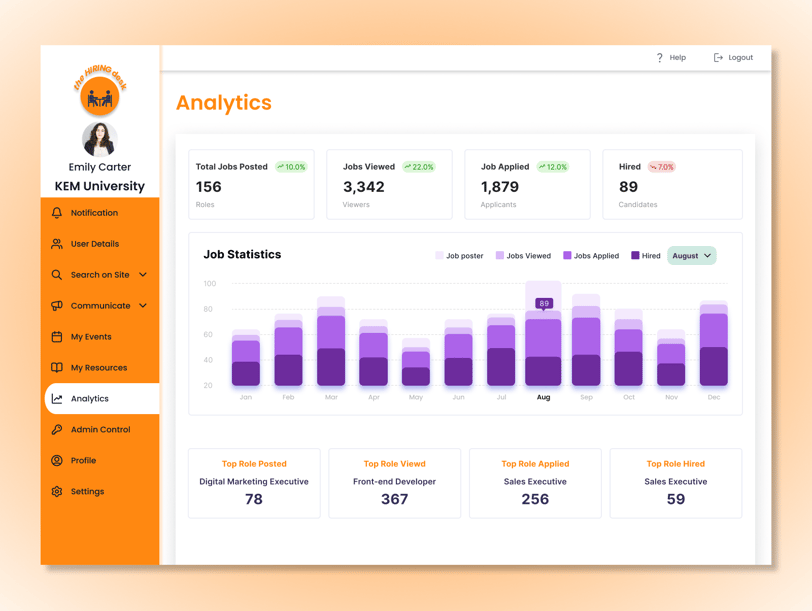

Educational Institute Representative's Screen
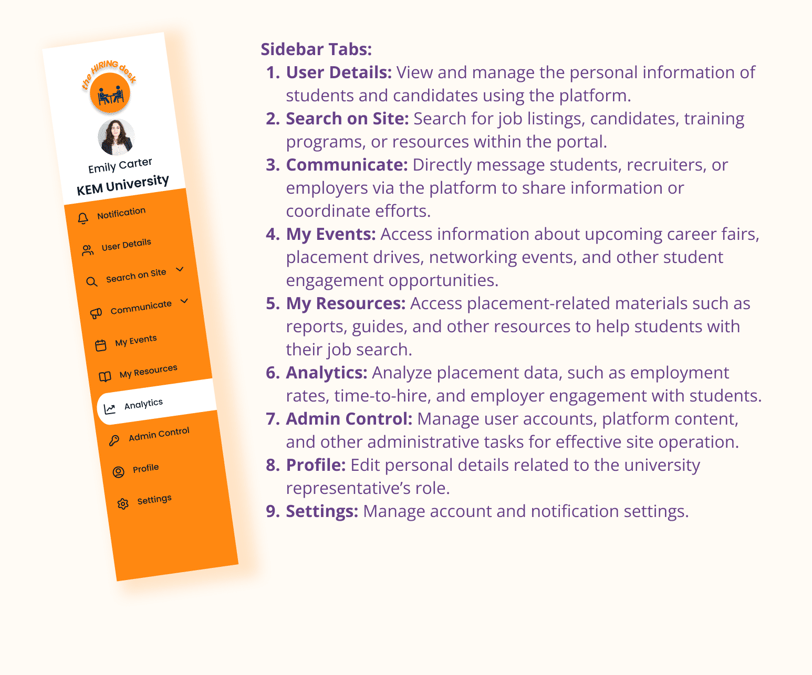



Educational Institute Representative's Screen


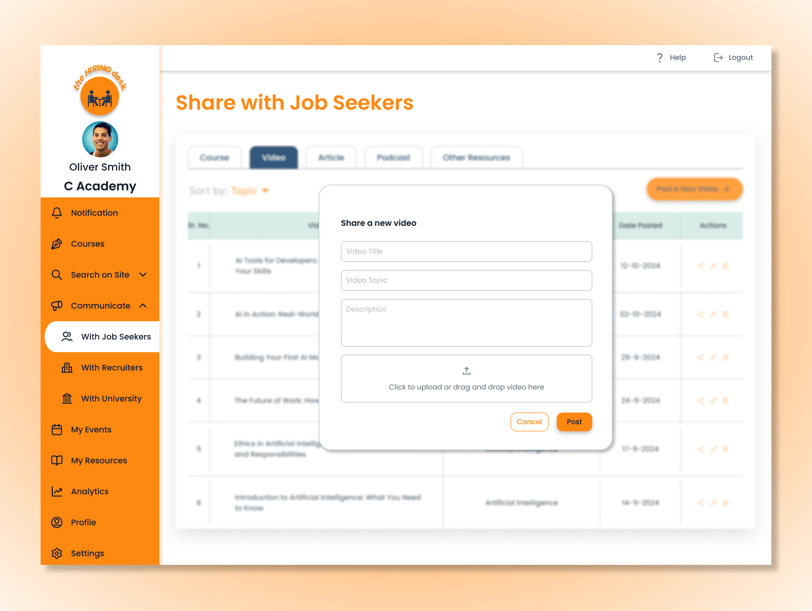

Training Provider's Screen
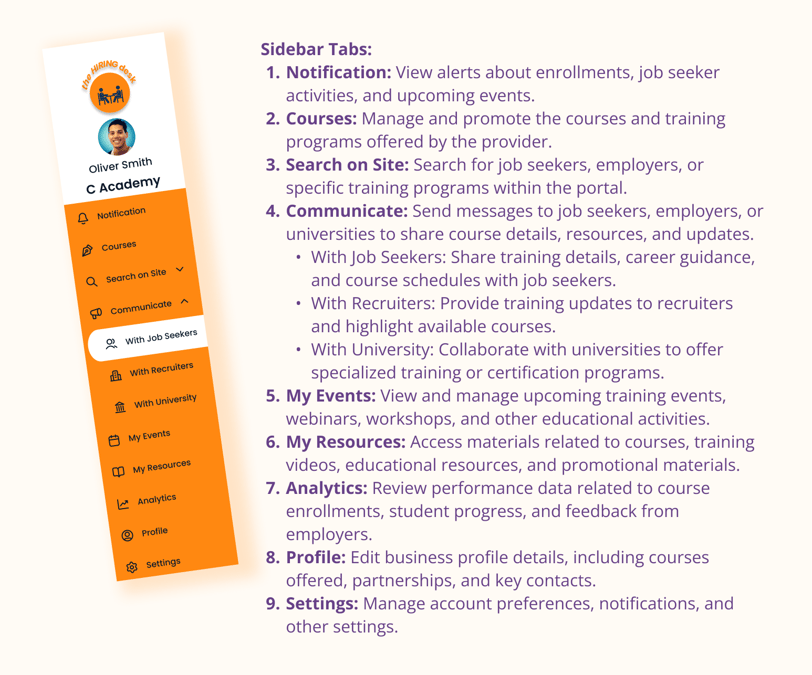



Training Provider's Screen


Scope of “The HIRING Desk”
The scope of “The HIRING Desk” defines the specific parameters and focus areas of the platform, ensuring it effectively addresses the regional challenges of skills shortages, mismatches, and unemployment. Here are the key points:
1. Geographic Focus:
Description: “The HIRING Desk” targets a specific geographic region to address local issues of skills shortages and mismatches.
Impact: This focused approach enables tailored solutions that meet the unique needs of the regional labour market.
2. Stakeholder Identification:
Description: Regional Employers, Job Seekers, and Educational Institutes are identified as the major stakeholders of the platform.
Impact: Engaging these key groups ensures that the platform addresses the specific needs and challenges faced by each stakeholder.
Description: The Educational Institute is designated as the administrator of the site, overseeing its operations and user engagement.
Impact: This central role ensures reliable governance and management of the platform.
3. Role of the Educational Institute:
4. University Administration:
Description: The main university operating in the region is considered the primary administrator of the portal.
Impact: The involvement of the university lends credibility to the platform and enhances its connection with local educational resources.
Description: Other colleges, institutes, and training providers in the region can register on the site, but the university retains sole administrative authority.
Impact: This structure encourages collaboration among various educational institutions while maintaining a unified management approach.
5. Inclusion of Other Educational Entities:
6. Definition of Job Seekers:
Description: Current university students, alumni, and local job seekers are all categorized as Job Seekers on the platform.
Impact: This broad definition allows for a diverse pool of candidates, enhancing the opportunities available for employers.
The scope of “The HIRING Desk” defines the specific parameters and focus areas of the platform, ensuring it effectively addresses the regional challenges of skills shortages, mismatches, and unemployment. Here are the key points:
1. Geographic Focus:
Description: “The HIRING Desk” targets a specific geographic region to address local issues of skills shortages and mismatches.
Impact: This focused approach enables tailored solutions that meet the unique needs of the regional labour market.
2. Stakeholder Identification:
Description: Regional Employers, Job Seekers, and Educational Institutes are identified as the major stakeholders of the platform.
Impact: Engaging these key groups ensures that the platform addresses the specific needs and challenges faced by each stakeholder.
3. Role of the Educational Institute:
Description: The Educational Institute is designated as the administrator of the site, overseeing its operations and user engagement.
Impact: This central role ensures reliable governance and management of the platform.
4. University Administration:
Description: The main university operating in the region is considered the primary administrator of the portal.
Impact: The involvement of the university lends credibility to the platform and enhances its connection with local educational resources.
5. Inclusion of Other Educational Entities:
Description: Other colleges, institutes, and training providers in the region can register on the site, but the university retains sole administrative authority.
Impact: This structure encourages collaboration among various educational institutions while maintaining a unified management approach.
Description: Current university students, alumni, and local job seekers are all categorized as Job Seekers on the platform.
Impact: This broad definition allows for a diverse pool of candidates, enhancing the opportunities available for employers.
6. Definition of Job Seekers:
Scope of “The HIRING Desk”
Dependence on Stakeholder Engagement: The success of the platform relies heavily on active participation from Employers, Job Seekers, and Educational Institutes. Low engagement from any of these groups could hinder the portal's effectiveness in addressing skills shortages and mismatches.
Regional Focus: By concentrating on a specific geographic region, the portal may overlook broader employment trends and opportunities that exist outside its defined area, potentially limiting its effectiveness for job seekers and employers looking for wider reach.
Financial Considerations: The portal does not account for any financial aspects, as decisions regarding funding and financial policies are solely dependent on the educational institutes involved. This limitation may affect the sustainability and scalability of the platform.
Limitations of the Proposed Solution
Data Privacy and Security: As with any online platform, there are inherent risks related to data privacy and security. Ensuring the protection of user information is crucial, and any breaches could undermine trust in the portal.
Technological Limitations: The effectiveness of the portal is contingent upon the technology used. Any technical issues or limitations in the platform's 312 functionality could disrupt user experience and hinder communication among stakeholders.
Limitation of the Proposed Solution
The portal does not account for any financial aspects, as decisions regarding funding and financial policies are solely dependent on the educational institutes involved. This limitation may affect the sustainability and scalability of the platform.
Financial Considerations:
Regional Focus:
By concentrating on a specific geographic region, the portal may overlook broader employment trends and opportunities that exist outside its defined area, potentially limiting its effectiveness for job seekers and employers looking for wider reach.
Dependence on Stakeholder Engagement:
By concentrating on a specific geographic region, the portal may overlook broader employment trends and opportunities that exist outside its defined area, potentially limiting its effectiveness for job seekers and employers looking for wider reach.
As with any online platform, there are inherent risks related to data privacy and security. Ensuring the protection of user information is crucial, and any breaches could undermine trust in the portal.
Data Privacy and Security:
The effectiveness of the portal is contingent upon the technology used. Any technical issues or limitations in the platform's functionality could disrupt user experience and hinder communication among stakeholders.
Technological Limitations:
Expected Outcomes from “The HIRING Desk”
For the Job Seekers
Provides a platform for creating a resume that lists all skills and certificates.
Facilitates self-assessment regarding job readiness and market requirements.
Offers a platform for direct connection with employers and mentors, allowing job seekers to ask queries.
Delivers updates on current skill requirements, selection procedures, and market trends.
Enables regional employers to post and hire easily for their vacancies.
Saves hiring costs and time.
Provides a platform for direct connection with Educational Institutes, allowing for feedback and reviews regarding the hiring experience (positive or negative).
Offers a ready platform for communication and collaboration with students, job seekers, and institutes regarding various events organized.
For the Employers
Provides a platform for direct connection with job seekers.
Delivers real-time and authentic data to understand employment-related situations in the region.
Reduces dependencies on external research regarding job markets.
Provides sufficient information to gauge employment-related situations for the formulation of various policies.
For the Educational Institutes
For the Government
Expected Outcomes from “The HIRING Desk”
For the Job Seekers
Provides a platform for creating a resume that lists all skills and certificates.
Facilitates self-assessment regarding job readiness and market requirements.
Offers a platform for direct connection with employers and mentors, allowing job seekers to ask queries.
Delivers updates on current skill requirements, selection procedures, and market trends.
Enables regional employers to post and hire easily for their vacancies.
Saves hiring costs and time.
Provides a platform for direct connection with Educational Institutes, allowing for feedback and reviews regarding the hiring experience (positive or negative).
Offers a ready platform for communication and collaboration with students, job seekers, and institutes regarding various events organized.
For the Employers
Provides a platform for direct connection with job seekers.
Delivers real-time and authentic data to understand employment-related situations in the region.
Reduces dependencies on external research regarding job markets.
Provides sufficient information to gauge employment-related situations for the formulation of various policies.
For the Educational Institutes
For the Government
Conclusion
This thesis has thoroughly examined the challenges of skill shortages and mismatches within the labor market, presenting The HIRING Desk as an innovative solution to these critical issues. Grounded in the principles of Systems Thinking and the concepts outlined by Donella Meadows, particularly her identification of leverage points within complex systems, this digital platform aims to enhance communication and collaboration among Job Seekers, Educational Institutes, and Employers. By focusing on these leverage points, The HIRING Desk seeks to implement data-driven solutions that empower stakeholders to make effective decisions, bridging the gap between education and employment.
Donella Meadows emphasized that small changes in specific areas of a system can lead to significant improvements. By applying this concept, The HIRING Desk addresses immediate concerns while fostering a more adaptive and responsive labor market. The integration of data-driven insights allows for targeted interventions that effectively tackle the root causes of skill mismatches.
While it is essential to acknowledge the limitations of the proposed solution, its potential for transforming the recruitment landscape is profound. Ultimately, implementing The HIRING Desk represents a significant step forward in addressing the complexities of employment and education. By leveraging Systems Thinking and data-driven insights, we aspire to create a more efficient labor market that meets the evolving needs of both employers and job seekers, paving the way for future research and development in this vital area.
References
[1] Meadows, Donella H. (2009). Thinking in systems : a primer. London ; Sterling, VA :Earthscan, p.11.
[2] Richmond, B. (1994). Systems Dynamics/Systems Thinking: Let’s Just Get On With It. In International Systems Dynamics Conference. Sterling, Scotland.
[3] Senge, P. (1990). The Fifth Discipline, the Art and Practice of the Learning Organization. New York, NY: Doubleday/Currency.
[4] Meadows, Donella H. (2009). Thinking in systems : a primer. London ; Sterling, VA :Earthscan.
[5] Meadows, Donella H. (2009). Thinking in systems : a primer. London ; Sterling, VA :Earthscan, p.152.
[6] Meadows, Donella H. (2009). Thinking in systems : a primer. London ; Sterling, VA :Earthscan, p.151.
Thank You
Conclusion
This thesis has thoroughly examined the challenges of skill shortages and mismatches within the labor market, presenting The HIRING Desk as an innovative solution to these critical issues. Grounded in the principles of Systems Thinking and the concepts outlined by Donella Meadows, particularly her identification of leverage points within complex systems, this digital platform aims to enhance communication and collaboration among Job Seekers, Educational Institutes, and Employers. By focusing on these leverage points, The HIRING Desk seeks to implement data-driven solutions that empower stakeholders to make effective decisions, bridging the gap between education and employment.
Donella Meadows emphasized that small changes in specific areas of a system can lead to significant improvements. By applying this concept, The HIRING Desk addresses immediate concerns while fostering a more adaptive and responsive labor market. The integration of data-driven insights allows for targeted interventions that effectively tackle the root causes of skill mismatches.
While it is essential to acknowledge the limitations of the proposed solution, its potential for transforming the recruitment landscape is profound. Ultimately, implementing The HIRING Desk represents a significant step forward in addressing the complexities of employment and education. By leveraging Systems Thinking and data-driven insights, we aspire to create a more efficient labor market that meets the evolving needs of both employers and job seekers, paving the way for future research and development in this vital area.
References
[1] Meadows, Donella H. (2009). Thinking in systems : a primer. London ; Sterling, VA :Earthscan, p.11.
[2] Richmond, B. (1994). Systems Dynamics/Systems Thinking: Let’s Just Get On With It. In International Systems Dynamics Conference. Sterling, Scotland.
[3] Senge, P. (1990). The Fifth Discipline, the Art and Practice of the Learning Organization. New York, NY: Doubleday/Currency.
[4] Meadows, Donella H. (2009). Thinking in systems : a primer. London ; Sterling, VA :Earthscan.
[5] Meadows, Donella H. (2009). Thinking in systems : a primer. London ; Sterling, VA :Earthscan, p.152.
[6] Meadows, Donella H. (2009). Thinking in systems : a primer. London ; Sterling, VA :Earthscan, p.151.
